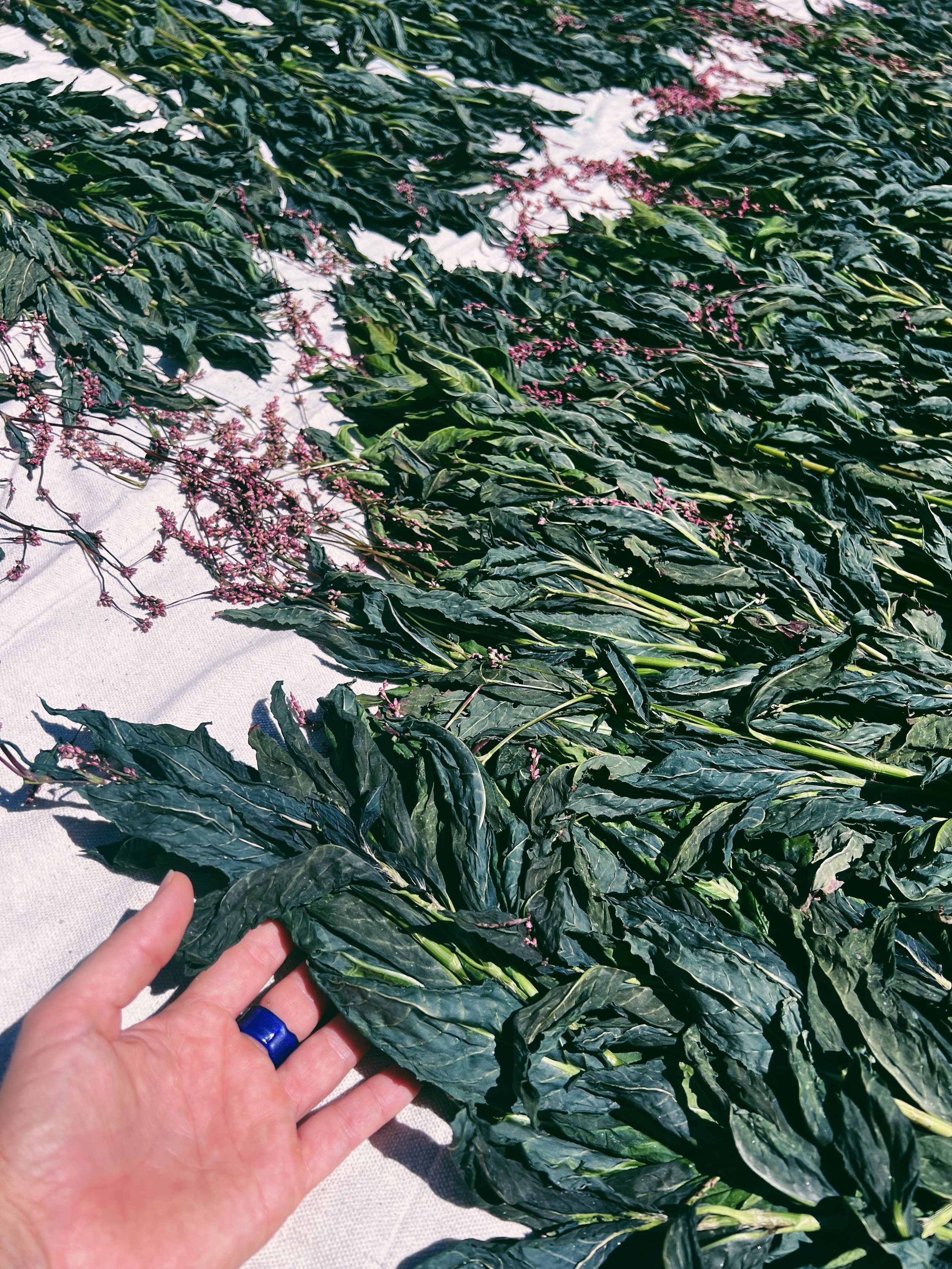Indigo Offerings
Fresh Leaf Indigo & Woad Dyeing
The following technique will work with many varieties of indigo plants (Indigofera species, Persicaria tinctoria/Japanese indigo, Strobilanthes cusia, Isatis tinctoria or Isatis indigotica/European & Chinese Woad) and can be used to create blues, aqua & turquoise that are truly unattainable from any other single dyestuff process. NO VAT NEEDED.
Dyeing with fresh leaf indigo/woad feels like pure natural magic! The simplicity of this process is alluring, kid friendly & refreshing for summer time dyeing when temps can be hot, and the last thing you may want to do is fire up a stove for dye.
It’s the EASIEST indigo dyeing method and this technique can be done in multiple ways including an eco friendly NO WATER method.
Learn all this & more including:
Seed Starting & my preferred growing methods
Harvesting Tips & Dye Considerations
Multiple Fresh Leaf Dyeing Methods- No Water Method Included!
Indigo Plant & Soymilk Science
How to Dye stubborn plant fibers like cotton and linen with fresh leaves
Rooting and replanting Indigo and MUCH more!
Dried Indigo Leaves
The dried leaf vat is a very special organic method using ANY amount of dried Indigo Leaves (‘Persicaria tinctorial’ aka: Japanese Indigo)
Summer is BUSY! Spend more time enjoying the outdoors & less time stressing over extracting or dyeing with all your fresh indigo leaves. You can DRY the leaves to store for future off season dye Vat making without the lengthy process of extracting, oxidizing & settling pigment first.
It was previously thought that at minimum 7kg / 15 lbs (multiple year’s worth of dried leaves for most growers) is needed to process/compost & make an Indigo Vat, but NOW you can use my dried leaf vat recipe to process your dried indigo leaves in ANY QUANTITY to make an organic vat ~ AND with NO Thiox or Hydros (synthetic indigo reducers)
AND this recipe includes extracting yellow from the SAME dried leaves to overdue & make GREEN!
My Dried Leaf Vats have impressed me beyond my initial expectations of what could be done with a relatively small amount of dried leaves - I’ve tested this method with as little as 30grams of dried leaves with success!
Find this remarkable organic —DRIED LEAF VAT— method & recipe with detailed process & procedural steps in my Indigo Vat Workshop.
Tatakizome -or- Leaf Pounding/Hammering with Indigo & Woad
Indigo & woad leaves of all varieties can be printed on fabric with physical pressure using a hammer or mallet. The word in the Japanese language for this technique is- ‘Tatakizome’ たたき染め
‘Tatakizome’ たたき染め (combining words ‘Tataki’ -to beat- and ‘Zome’ -dyeing-)
The color will initially appear green, but with oxidation and washing the prints become more blue over time as the green and yellow dyes dissipate and fade.
This method including advice on getting the bluest and clearest prints possible is covered in June’s lesson of A Year in Natural Dyes- click the button to learn more and ACCESS the informative lesson. **The lesson also covers a fun creative leaf cutting technique to create shapes, letters, numbers from the leaves!
A Rainbow of Colors from Indigo Leaves
Don’t throw away your leftover fresh indigo dye bath or liquid- and continue to reap multiple color rewards from the same batch of leaves including pinks and purples from ‘Indirubin’ (another dye compound all indigo bearing plants are capable of creating), and yellows, tans, olive green & brown from flavonoids found within the leaves as well.
This tutorial includes 6 sections on making a whole rainbow of colors from only indigo or woad leaves as well as how to dye Purple Indirubin tones with dried green Indigofera leaves- a great process that ANYONE can try even if you’re not growing indigo! This Tutorial also covers making pigment after creating many different colors from your leaves.
Also described in my Fresh Indigo Workshop which includes a more simplified explanation of the Indigo Spectrum Rainbow process.
Indigo Pigment Extraction
Extracting Indigo Pigment from your own indigo leaves is an incredibly satisfying & educational experience.
Homegrown indigo pigment can be used for making indigo vats (see my Indigo Vat Workshop for specific advice on making a specialized Indigo Vat with Homegrown Pigment) & Artist Materials such as ink, Paints, Pastels, Crayons, Oil Sticks, etc.
This process will be demonstrated in full from garden leaves to dry pigment, showing step by step how to most effectively create your own shelf stable homegrown blue pigment. The workshop also explains how to make a double extraction from leaves!
Also learn a direct vatting method (starting with fresh leaves & ending with an indigo vat without having to dry pigment). There’s nothing like extracting your own indigo to contribute to a more holistic understanding of indigo’s distinctly different process and chemistry within the context of natural dyes.
Fresh Indigo/Woad Stencil Printing
A wonderful technique to create surface designs with fresh indigo or woad. This technique requires small amounts of fresh indigo or woad leaves, so it’s perfect even if you’re only growing one or two plants.
AND I will show you how to make it work on protein/animal fibers as well as cellulose/plant fibers!
This tutorial shows how to make custom biodegradable stencils without using synthetic materials or plastic stencils as well as how to reuse existing plastic you may already have in your recycling bin.
This technique can also be used for other dye plants on mordanted fabric!







